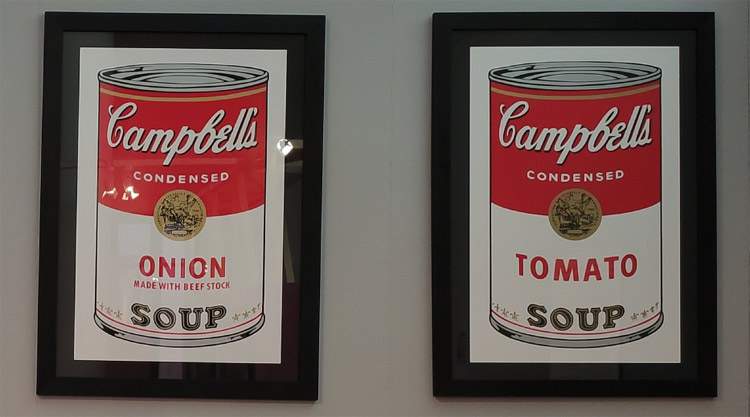This summer (and beyond), Andy Warhol ( Pittsburgh, 1928 - New York, 1987) is the star of a major exhibition in Puglia, spread over three venues: the Palazzo Ducale in Martina Franca (Taranto), the Norman Swabian Castle in Mesagne (Brindisi) and the Palazzo Tanzarella in Ostuni (Brindisi). Entitled Andy Warhol. The Alchemist of the Sixties and curated by Maurizio Vanni, the exhibition represents the Apulian leg of the exhibition held at the Villa Reale in Monza in the spring: more than one hundred works by the father of Pop Art reconstruct his career with an itinerary that ranges from the most famous icons (from Marilyn to the series dedicated to John and Jacqueline Kennedy, from the icons of Mao to Coca-Cola and Cambpell soups, and will not miss the famous Ladies and gentelmen series, one of the symbols of the sexual revolution, and the Camouflages) to lesser-known productions.
The exhibition takes place from May 23 to December 9, 2019, and its goal is not only to show the public the stages of Andy Warhol’s career, but to relate his art to the context in which it was produced: the rise and rise of consumer society and the strong changes that American society experienced between the 1960s and the 1980s. Changes of which Andy Warhol was one of the most eloquent interpreters, on all levels: not only on the level of content, but also on that of technical aspects. Warhol, as is well known, was a staunch proponent of the reproducibility of works of art, and seriality became a founding element of his art, both as it was linked to the modes of communication that took hold in the years of the economic boom in America and as it was linked to his idea of the democratic nature of art.
Andy Warhol. The Alchemist of the Sixties is divided into six sections: Consumerism, Everyday Objects and Seriality , which introduces some of the founding elements of Andy Warhol’s art; Famous People. For Use and Consumption, dedicated to the portraits the Pittsburgh artist executed for celebrities of the era in which he lived, Love of Music. From Producer to Creator , which exposes to the public some of his most famous works in the field of music (the very famous banana for the cover of the Velvet Underground’s debut album is perhaps his best-known work belonging to this strand), Sexual Revolution. From ’68 to Ladies and Gentlemen , which investigates Warhol’s role in the costume revolution, Marilyn, Jackie and John F. Kennedy. Myths Beyond Time, dedicated to the most recognizable icons of his art, and Pop Now. New Identities in Apulian Arts, a section that photographs the evolution of Pop Art in Apulian reality, featuring works by local artists.
Regarding the latter section, curated by Michela Laporta, the public will get to know a selection of more than sixty works, distributed in the three venues of the exhibition, which are the result of creativity derived from those currents daughters of Pop Art, such as Neo Pop and Neo Dada. The intent of curator Michela Laporta is to create a continuity between Andy Warhol’s art and the productions of young Apulian artists by highlighting the importance that “popular” art still has today. The figure of Warhol is therefore understood as a starting point to create a thematic context through artists who have transposed his aesthetics by exhibiting paintings, installations, combine painting, mixed media and ready-made. The itinerary consists of visual references and analogies to the themes, messages and compositional methods of Warhol’s art, without forgetting the difference that distinguishes Italian Pop Art from American Pop Art: in fact, if in the United States pop icons were mostly linked to products of mass consumption, in Italy it was the historical, artistic and cultural tradition that became the subject of the works, so there will also be pieces that were born looking deeply at the territorial identity of our region.
For the section on Pop Art in Apulia, 32 authors have been selected, including established artists also in the international sphere and young emerging ones: particular prominence is acquired by the drawings made by Pino Pascali (Bari, 1935 - Rome, 1968) for Carosello in the 1960s, a perfect synthesis of his brilliant irony, and a precious testimony of the link that unites art to the mass media through graphic expression, annulling any hierarchy between the arts.
The exhibition opens daily from 10 a.m. to 1 p.m. and 3 to 8 p.m. (last entry 30 minutes before closing). Ticket prices, valid for all three venues (no expiration date): full 10 euros, reduced (for over 65, students under 26, accompanying disabled persons, journalists) 8 euros, free for disabled persons, tour guides, children up to 5 years old. Single venue ticket costs 7 euros. Discounts are available for groups of at least 12 people and for schools, and the possibility of planning visits to the exhibition with the help of the staff is open. For all information and reservations for visits, you need to contact our organizing secretary at: segreteria@warholpuglia.it. Guided tours are also possible: 50 euros the cost for one venue, 80 for two venues, 100 for three venues. For all information, visit the exhibition website: https://www.warholpuglia.it/.
Andy Warhol. The Alchemist of the Sixties is organized and produced by Puglia MICExperience and MetaMorfosi cultural association, in collaboration with Spirale d’Idee and under the patronage of Regione Puglia, City of Martina Franca, City of Mesagne, City of Ostuni. Official partner Federalberghi.
 |
| Andy Warhol, alchemist of the 1960s. In Apulia, an exhibition across three venues |
Warning: the translation into English of the original Italian article was created using automatic tools. We undertake to review all articles, but we do not guarantee the total absence of inaccuracies in the translation due to the program. You can find the original by clicking on the ITA button. If you find any mistake,please contact us.